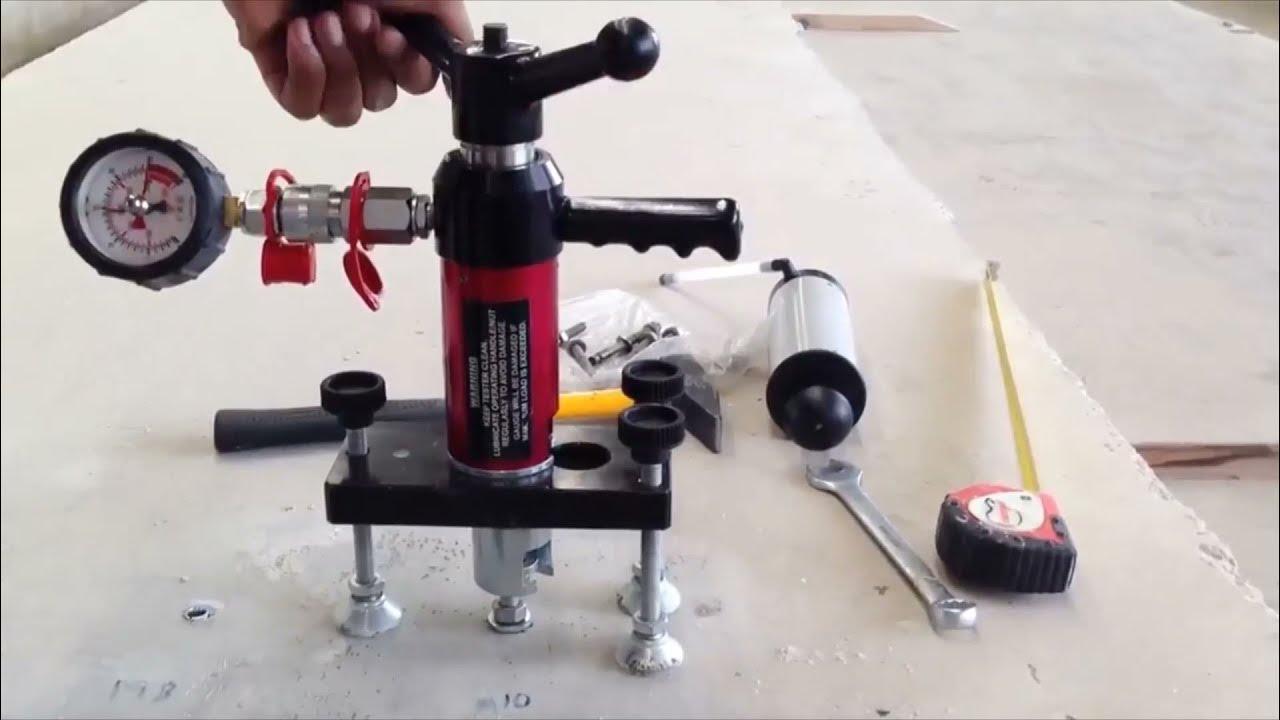In construction, securing structural components to ensure safety and integrity is crucial. This often involves using various types of anchors and bolts, such as drop-in anchors and anchor bolts. To verify the reliability and strength of these fastening systems, pull-out testing is conducted. This article delves into the specifics of pull-out testing, drop-in anchors, and anchor bolts, exploring their types, applications, advantages, and essential considerations in a detailed manner, providing a thorough understanding of their roles in contemporary construction practices.
Pull Out Testing
Definition and Overview
Pull-out testing is a method used to evaluate the strength and reliability of anchors and bolts embedded in construction materials. This test measures the force required to pull an anchor or bolt out of its substrate, providing critical data on the anchoring system’s performance and ensuring it meets the necessary safety standards.
Types of Pull Out Testing
Direct Tension Pull Test: This test involves applying a tensile load directly to the anchor or bolt until it is pulled out. It provides a clear measure of the anchoring system’s tensile strength.
Proof Load Testing: Instead of pulling the anchor out completely, a predetermined load is applied to ensure the anchor can withstand the specified forces without failure.
Torque Test: This test measures the rotational force required to turn the anchor or bolt within its substrate, providing insights into the anchoring system’s resistance to rotational forces.Drop In Anchor
Procedure
The general procedure for pull-out testing involves the following steps:
Preparation: The test area is prepared, ensuring the substrate is clean and free from any defects. The anchor or bolt is then installed according to manufacturer specifications.
Equipment Setup: A pull-out test apparatus is set up, which typically includes a hydraulic jack or a mechanical puller connected to a load cell to measure the applied force.
Testing: The force is gradually applied to the anchor or bolt until it is pulled out or the specified proof load is reached. The force applied and the displacement of the anchor or bolt are recorded.
Analysis: The data collected is analyzed to determine the pull-out strength and to identify any failure modes, such as concrete cracking or anchor deformation.
Applications
Pull-out testing is essential in various applications:
Quality Control: Ensuring that anchors and bolts meet the required performance standards before use in construction projects.
Safety Verification: Verifying the strength and reliability of anchors and bolts in critical structures, such as bridges, towers, and high-rise buildings.
Retrofitting and Repairs: Assessing the condition of existing anchors and bolts in older structures to determine the need for repairs or replacements.
Advantages
Accuracy: Provides precise data on the anchoring system’s performance, ensuring safety and reliability.
Compliance: Ensures that anchors and bolts meet industry standards and regulations.
Risk Mitigation: Identifies potential weaknesses in the anchoring system, allowing for corrective measures before failure occurs.
Considerations for Use
Substrate Condition: The condition of the substrate (e.g., concrete, masonry) can significantly affect the test results. It is essential to ensure the substrate is in good condition before testing.
Test Equipment Calibration: Regular calibration of test equipment is crucial for accurate measurements.
Environmental Factors: Factors such as temperature, moisture, and corrosion can impact the performance of anchors and bolts. These should be considered when analyzing test results.
Drop-In Anchors
Definition and Overview
Drop-in anchors are internally threaded concrete anchors used in medium to heavy-duty applications. They are inserted into a pre-drilled hole and expanded using a setting tool, providing a strong and reliable anchor point within the concrete.
Types of Drop-In Anchors
Standard Drop-In Anchors: These are the most common type, featuring an expansion mechanism that secures the anchor in the concrete once set.
Flush Mount Drop-In Anchors: Designed to sit flush with the concrete surface, these anchors are ideal for applications where a smooth finish is required.
Coated Drop-In Anchors: These anchors are coated with materials such as zinc or stainless steel to enhance corrosion resistance, making them suitable for outdoor and corrosive environments.
Materials
Drop-in anchors are typically made from materials such as carbon steel, stainless steel, and sometimes brass, chosen based on the application requirements and environmental conditions.
Applications
Mechanical and Electrical Installations: Used to secure machinery, electrical conduits, and other fixtures to concrete surfaces.
Structural Connections: Essential in securing structural components such as beams and columns to concrete foundations.
HVAC Systems: Used to anchor ductwork and other HVAC components to concrete ceilings and walls.
Advantages
High Load Capacity: Drop-in anchors provide a strong and reliable anchor point capable of withstanding substantial loads.
Versatility: Suitable for a wide range of applications, from light fixtures to heavy machinery.
Ease of Installation: Quick and straightforward installation process, requiring only a pre-drilled hole and a setting tool.
Considerations for Use
Hole Preparation: Proper hole preparation is crucial for ensuring the anchor sets correctly and provides the required strength.
Setting Tool: Using the correct setting tool is essential for expanding the anchor properly within the concrete.
Environmental Conditions: Consideration of environmental factors such as moisture and temperature is necessary to select the appropriate material and coating.
Anchor Bolts
Definition and Overview
Anchor bolts are heavy-duty fasteners used to attach structural and non-structural elements to concrete. They are embedded in the concrete and provide a secure and stable connection between the concrete and the attached components.
Types of Anchor Bolts
Cast-in-Place Anchor Bolts: These bolts are placed in position before the concrete is poured, becoming an integral part of the concrete structure. They are typically used in new construction.
Post-Installed Anchor Bolts: Installed into pre-drilled holes in existing concrete, these bolts are used for retrofitting and repairs. They include mechanical expansion anchors and chemical anchors.
Sleeve Anchor Bolts: These bolts expand upon tightening, securing themselves in the concrete. They are used for medium-duty applications.
Wedge Anchor Bolts: Featuring a wedge mechanism, these bolts provide high strength and are used in heavy-duty applications.
Materials
Anchor bolts are made from various materials, including carbon steel, stainless steel, and galvanized steel, chosen based on the required strength and environmental conditions.
Applications
Foundations: Used to secure structural elements such as columns and beams to concrete foundations.
Machinery and Equipment: Essential in anchoring heavy machinery and equipment to concrete floors.
Bridges and Infrastructure: Used in the construction of bridges and other infrastructure projects to ensure stable connections between different structural components.
Advantages
High Strength: Anchor bolts provide robust and reliable connections capable of withstanding significant loads and stresses.
Durability: Designed to endure harsh environmental conditions, including corrosion, temperature changes, and mechanical wear.
Versatility: Available in various types and sizes to suit a wide range of applications and installation requirements.
Considerations for Use
Installation Technique: Proper installation is critical for ensuring the anchor bolt provides the required strength and stability. This includes correct hole preparation, proper insertion, and adequate curing time for chemical anchors.
Material Selection: Choosing the appropriate material based on environmental conditions and load requirements is essential for long-term performance.
Inspection and Maintenance: Regular inspection and maintenance are necessary to ensure the anchor bolts remain in good condition and continue to provide reliable performance.
Comparative Analysis: Drop-In Anchors vs. Anchor Bolts
Functional Differences
Purpose: Drop-in anchors are primarily used for medium to heavy-duty applications within concrete, providing internal threads for bolting components. Anchor bolts are used to secure structural and non-structural elements to concrete, with a focus on heavy-duty applications and load-bearing connections.
Installation: Drop-in anchors require a pre-drilled hole and a setting tool to expand the anchor within the concrete. Anchor bolts can be cast-in-place or post-installed, with various installation techniques depending on the type of bolt.
Material and Application Specifics
Material Compatibility: Both drop-in anchors and anchor bolts must be compatible with the materials they are used with to prevent corrosion and ensure durability. This includes considering the environmental conditions and selecting appropriate coatings and materials.
Load Requirements: Drop-in anchors are suitable for medium to heavy loads, while anchor bolts are designed for heavy-duty applications, providing high strength and stability. Shear Stud
Advantages and Limitations
Ease of Installation: Drop-in anchors offer a quick and straightforward installation process, making them suitable for a wide range of applications. Anchor bolts, especially cast-in-place and chemical anchors, require more precise installation techniques but provide superior strength and reliability.
Strength and Durability: Anchor bolts offer higher strength and durability compared to drop-in anchors, making them ideal for critical structural connections and heavy machinery anchoring.
Conclusion
Pull-out testing, drop-in anchors, and anchor bolts are integral components in modern construction, each playing a crucial role in ensuring the safety, integrity, and performance of structures. Pull-out testing provides essential data on the strength and reliability of anchoring systems, ensuring they meet the necessary standards and regulations. Drop-in anchors offer versatile and reliable solutions for medium to heavy-duty applications within concrete, while anchor bolts provide robust connections for heavy-duty applications and load-bearing connections.





